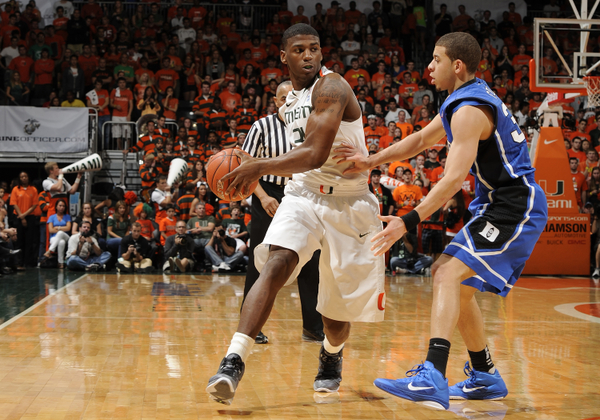The Missing Ingredient: Contenders Edition
Posted by zhayes9 on October 26th, 2011 Zach Hayes is an editor, contributor and bracketologist for Rush the Court.
Zach Hayes is an editor, contributor and bracketologist for Rush the Court.
On February 2, eventual national champion Connecticut found their missing ingredient.
Before that date, Huskies fans already had a sense their team could finish higher than the coaches selection of tenth in the Big East. Riding the heroics of Kemba Walker, they cruised through Maui, upset Texas on the road and dispatched of Villanova and Tennessee. Their sparkplug, leading scorer, energizer and team leader, Walker truly was Mr. Everything for the Huskies through the first three months of the season, but championships aren’t won by one player surrounded by incapable parts. Every critical eye knew that if Walker scuffled, as he did shooting 18-for-50 during two losses to Pitt and Notre Dame, the Huskies simply had no chance.
The talented junior drew double teams on every possession. He had no choice but to shoot 25 times per game. UConn’s late-game strategies became all too predictable. Someone else had to step up. Jim Calhoun, and Connecticut fans by extension, knew their team couldn’t reach a Final Four until a second option emerged alongside Walker.
By early February, Jeremy Lamb appeared to be that player. A 22-point, 4-rebound, 5-steal performance at Syracuse was his third consecutive outing with 20+ points. Lamb played with an understated confidence, lacked the typical freshman jitters late in games and confidently stroked jumpers. He developed into a consistent threat that defenses had to take seriously. Some inconsistent outings followed, but by March Lamb was the partner-in-crime Calhoun so desperately needed. The rest is history.
For contenders around the country, there is one fatal flaw that has the potential to derail their high hopes for this upcoming season. The flaw may take the entire non-conference slate to identify and most of league action to try to correct, but by March this glaring weakness must be solved in order for these elite teams to reach their lofty goals.

Reggie Bullock: UNC's missing ingredient?/ MSNBC
North Carolina: Consistent three-point shooting threat. Since I’m fairly confident Dexter Strickland can spell Kendall Marshall at the point for 3-4 minutes per half, the only other flaw I can identify for the overwhelming national title favorites is the lack of an outside shooting weapon. Unless someone emerges as a perimeter shooting threat, defenses will pack the post and dare Carolina to make jumpers, a problem further exacerbated by wing Leslie McDonald (38% 3FG) tearing up his knee this summer. The most obvious resolution is Harrison Barnes, an All-American candidate perfectly capable of extending his range beyond the arc and improving on his 34% mark from deep. Blue-chip signee P.J. Hairston has the reputation of a premiere outside shooter, but relying on freshmen to make shots is often precarious. Most of McDonald’s minutes could go to sophomore Reggie Bullock. The Tar Heel faithful hope Bullock is the answer following a disappointing and injury-plagued rookie campaign.
Kentucky: Post presence. John Calipari’s roster this season is an enviable mix of super-talented freshmen bound for the lottery and seasoned veterans who know their proper role. Senior Darius Miller and sophomores Terrence Jones and Doron Lamb all return, but it’s the departure of center Josh Harrellson that could prove the biggest loss, a notion Kentucky fans could have never envisioned at this time a year ago. Harrellson was more than willing to do the post’s dirty work, snatching key rebounds, blocking shots and mixing it up with the likes of Jared Sullinger and Tyler Zeller. Although Anthony Davis and Kyle Wiltjer don’t lack in the height department, they’re more perimeter-oriented bigs without the necessary bulk to bang with elite, upperclassmen centers. Unless Eloy Vargas makes a gigantic leap forward, any team with a true post presence could give Kentucky fits.
Connecticut: Go-to scorer. The rumblings around the UConn program are true – this year’s unit is more talented top-to-bottom than last year’s national champions. The two pitfalls in that argument are 1) the Huskies lost the most indispensable player in college basketball in Walker and 2) the sport as a whole is substantially more talented than a season ago. Lamb played the role of Robin to Walker’s Batman to perfection down the stretch as a freshman, but transitioning to the player everyone in the huddle expects to take and make shots with the season on the line is an entirely different animal. Lamb carries the vibe of a player unmoved by the brightest of lights and certainly sunk his fair share of crucial baskets last March, providing optimism he’s fit for such a starring role. Andre Drummond could also be That Guy, or maybe Alex Oriakhi takes a huge step forward. Someone must take the baton if UConn hopes to become the first repeat champs since the Noah-Horford-Brewer Gators.
Ohio State: Post partner with Sullinger. Jared Sullinger passed up on the lottery to return to school for a multitude of reasons: he wants to avenge last year’s early exit from the NCAA Tournament, the return of William Buford, Aaron Craft and DeShaun Thomas ensures Sullinger won’t be returning to a bare cupboard, and college is also pretty fun when you’re the big man on a sports-crazed campus. Those reasons may all be applicable, but the primary reason Sullinger stayed was to prove to NBA scouts he could play power forward at the next level. He’s shed baby fat and developed an outside shooting game to complement his already advanced post repertoire. Thad Matta is comfortable with allowing Sullinger to roam around the perimeter more as a sophomore. The problem: with Dallas Lauderdale gone, the Buckeyes will now need a post defender/rebounder/glass protector to crack Matta’s notoriously thin rotation and do the dirty work without Sullinger constantly planting his rear end in the paint. The most likely option: 6’10″ freshman Amir Williams.
Syracuse: A more reliable Scoop Jardine. The polarizing point guard is Syracuse’s best playmaker and personality, but as a senior Jardine must develop a keener sense of the moment in order for the Orange to match lofty expectations. A truly solid season in 2010-11 (32.1 MPG, 12.5 PPG, 5.9 APG, 46% 2FG, 36% 3FG) was marred by head-scratching decisions late in crucial ballgames. Jardine often reacted to a made three as an invitation to fire up two more ill-advised bricks. He forced the action with dribble penetration, resulting in costly turnovers and easy baskets for the opposition. His points per weighted shot totals display his ineptitude in percentage form. As a floor general, Jardine needs to watch film on Kemba Walker last year and take notes on when to attack, when to pass, when to force the action and when to get teammates involved. An abundance of experience in late-game scenarios will only harden the prideful senior, so anticipating a dramatic improvement in this capacity isn’t far-fetched.
Vanderbilt: Toughness late in games. To label the regular season meaningless for Vanderbilt is an overstatement. But everyone, from head coach Kevin Stallings on down, will admit that the NCAA Tournament is where the Commodores have to prove themselves after this group – led by Jeffery Taylor, John Jenkins and Festus Ezeli – dropped opening-round contests as heavy favorites the last two springs. Mental toughness, tenacity and will are nearly impossible to measure, but the fact Vandy finished just 11-11 in games decided by 11 points or less and their defense ranked tenth in the SEC in per-possession defenses is glaring. Jenkins, Taylor and Ezeli are all immensely talented and Stallings is a phenomenal X’s and O’s coach, but Vandy can’t shrink and freeze up late in games like they have so many times over the last two seasons. Embracing the pressures of March is a prerequisite for any hopeful champion.
Duke: Perimeter defense. Despite the losses of productive seniors Kyle Singler and Nolan Smith along with #1 overall pick Kyrie Irving, Duke should still be offensively sound. They’ll score the basketball behind a plethora of shooters, a relatively deep bench and skilled big men. Where I’m afraid Duke might be exposed is by opposing scoring guards, from Ohio State’s William Buford and Temple’s Ramone Moore outside of league play to Florida State’s Michael Snaer and Miami’s Durand Scott once the ACC slate rolls around. Starting point guard Seth Curry was often exposed as a defender last season, wing Andre Dawkins has been benched in the past for porous defense and hyped freshman Austin Rivers will score 20 PPG, but might give up close to that defensively on a nightly basis. Extensive dribble penetration and easy paths to the basket means foul trouble for the Plumlee brothers, compounding an already tenuous situation for Duke. Curry or Dawkins must show rapid improvement on that end of the floor.
Louisville: Post defense/rebounding. The loss of senior leader and four-year contributor Preston Knowles was certainly significant, but the Cardinals may miss center Terrence Jennings even more. If guards Peyton Siva, Chris Smith or Kyle Kuric allowed their man to get by, Jennings was often waiting to clean up mistakes, leading the Big East in block percentage and altering countless more shot attempts. Rick Pitino hopes the emerging Gorgui Dieng fills in for the departed Jennings, but he’s extremely raw, inexperienced and only played 15 MPG as a freshman, albeit with promising production. If Dieng sustains an injury or takes a step back, the next best option at center is 6’10″ freshman Zach Price.
Florida: A productive Patric Young. Although there’s not enough shots or minutes available to please all four, Billy Donovan is pleased with Erving Walker, Kenny Boynton, Mike Rosario and Brad Beal as his backcourt rotation. The Gators may even employ four-guard sets this season, but that still leaves one frontcourt opening for Young to have an impact. The talented sophomore has an NBA-ready body and gained valuable experience playing for the U.S. U-19 team over the summer. Still, the fact Donovan’s best option down low averaged just 3.3 PPG and 3.7 RPG presents a potential flaw. Young must be entrusted to play 30 MPG, snatch every rebound in sight, guard the opposing team’s best big man (Sullinger, Ezeli, JaMychal Green, Renardo Sidney to name a few) and present enough of a scoring threat to keep teams from doubling the Florida guards.
Pittsburgh and Baylor: Stability at point guard. You never want the most important position on the floor to be a lingering question mark, but both Pitt and Baylor are faced with that daunting proposition. The good news for Pitt is that their answer is preseason Big East POY Ashton Gibbs, who will be asked (along with Travon Woodall) to orchestrate the offense following Brad Wanamaker’s departure, but will Gibbs sliding over to the point negate his tremendous ability to utilize screens for open jumpers? For Baylor, on-court chemistry derailed their NCAA hopes last season. This year, the Bears’ talent level is unrivaled in the Big 12, but they need a captain to operate their often directionless ship, and it appears A.J. Walton’s exorbitant turnover rate is too much of a liability. One of JC transfer Pierre Jackson or former BC Eagle Brady Heslip must grab the reins.










































